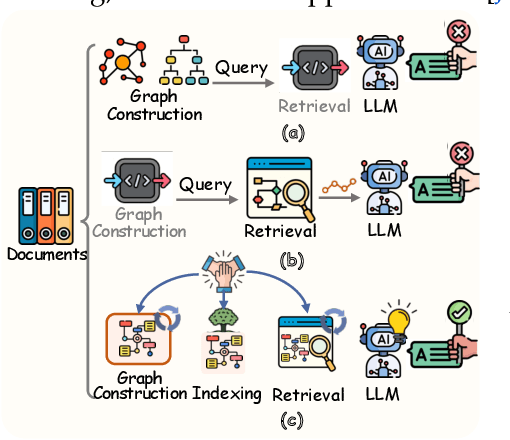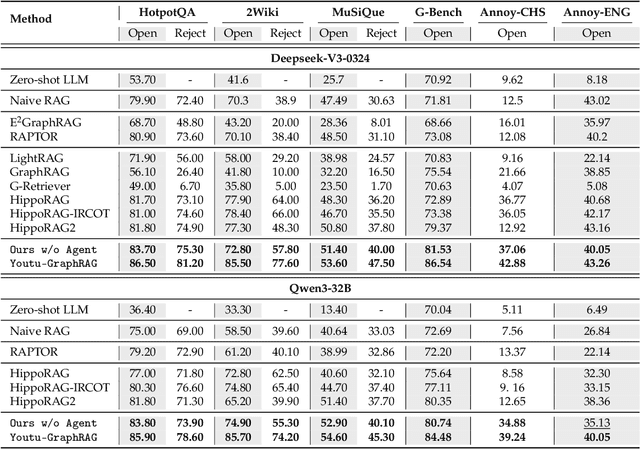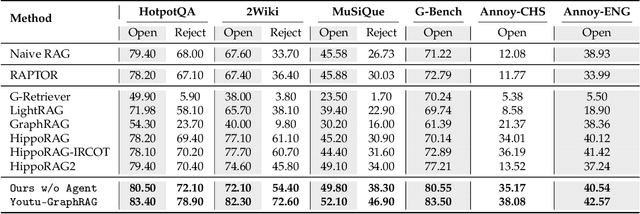Xiao Huang
Youtu-GraphRAG: Vertically Unified Agents for Graph Retrieval-Augmented Complex Reasoning
Aug 27, 2025



Abstract:Graph retrieval-augmented generation (GraphRAG) has effectively enhanced large language models in complex reasoning by organizing fragmented knowledge into explicitly structured graphs. Prior efforts have been made to improve either graph construction or graph retrieval in isolation, yielding suboptimal performance, especially when domain shifts occur. In this paper, we propose a vertically unified agentic paradigm, Youtu-GraphRAG, to jointly connect the entire framework as an intricate integration. Specifically, (i) a seed graph schema is introduced to bound the automatic extraction agent with targeted entity types, relations and attribute types, also continuously expanded for scalability over unseen domains; (ii) To obtain higher-level knowledge upon the schema, we develop novel dually-perceived community detection, fusing structural topology with subgraph semantics for comprehensive knowledge organization. This naturally yields a hierarchical knowledge tree that supports both top-down filtering and bottom-up reasoning with community summaries; (iii) An agentic retriever is designed to interpret the same graph schema to transform complex queries into tractable and parallel sub-queries. It iteratively performs reflection for more advanced reasoning; (iv) To alleviate the knowledge leaking problem in pre-trained LLM, we propose a tailored anonymous dataset and a novel 'Anonymity Reversion' task that deeply measures the real performance of the GraphRAG frameworks. Extensive experiments across six challenging benchmarks demonstrate the robustness of Youtu-GraphRAG, remarkably moving the Pareto frontier with up to 90.71% saving of token costs and 16.62% higher accuracy over state-of-the-art baselines. The results indicate our adaptability, allowing seamless domain transfer with minimal intervention on schema.
LoSemB: Logic-Guided Semantic Bridging for Inductive Tool Retrieval
Aug 11, 2025Abstract:Tool learning has emerged as a promising paradigm for large language models (LLMs) to solve many real-world tasks. Nonetheless, with the tool repository rapidly expanding, it is impractical to contain all tools within the limited input length of LLMs. To alleviate these issues, researchers have explored incorporating a tool retrieval module to select the most relevant tools or represent tools as unique tokens within LLM parameters. However, most state-of-the-art methods are under transductive settings, assuming all tools have been observed during training. Such a setting deviates from reality as the real-world tool repository is evolving and incorporates new tools frequently. When dealing with these unseen tools, which refer to tools not encountered during the training phase, these methods are limited by two key issues, including the large distribution shift and the vulnerability of similarity-based retrieval. To this end, inspired by human cognitive processes of mastering unseen tools through discovering and applying the logical information from prior experience, we introduce a novel Logic-Guided Semantic Bridging framework for inductive tool retrieval, namely, LoSemB, which aims to mine and transfer latent logical information for inductive tool retrieval without costly retraining. Specifically, LoSemB contains a logic-based embedding alignment module to mitigate distribution shifts and implements a relational augmented retrieval mechanism to reduce the vulnerability of similarity-based retrieval. Extensive experiments demonstrate that LoSemB achieves advanced performance in inductive settings while maintaining desirable effectiveness in the transductive setting.
You Don't Need Pre-built Graphs for RAG: Retrieval Augmented Generation with Adaptive Reasoning Structures
Aug 08, 2025Abstract:Large language models (LLMs) often suffer from hallucination, generating factually incorrect statements when handling questions beyond their knowledge and perception. Retrieval-augmented generation (RAG) addresses this by retrieving query-relevant contexts from knowledge bases to support LLM reasoning. Recent advances leverage pre-constructed graphs to capture the relational connections among distributed documents, showing remarkable performance in complex tasks. However, existing Graph-based RAG (GraphRAG) methods rely on a costly process to transform the corpus into a graph, introducing overwhelming token cost and update latency. Moreover, real-world queries vary in type and complexity, requiring different logic structures for accurate reasoning. The pre-built graph may not align with these required structures, resulting in ineffective knowledge retrieval. To this end, we propose a \textbf{\underline{Logic}}-aware \textbf{\underline{R}}etrieval-\textbf{\underline{A}}ugmented \textbf{\underline{G}}eneration framework (\textbf{LogicRAG}) that dynamically extracts reasoning structures at inference time to guide adaptive retrieval without any pre-built graph. LogicRAG begins by decomposing the input query into a set of subproblems and constructing a directed acyclic graph (DAG) to model the logical dependencies among them. To support coherent multi-step reasoning, LogicRAG then linearizes the graph using topological sort, so that subproblems can be addressed in a logically consistent order. Besides, LogicRAG applies graph pruning to reduce redundant retrieval and uses context pruning to filter irrelevant context, significantly reducing the overall token cost. Extensive experiments demonstrate that LogicRAG achieves both superior performance and efficiency compared to state-of-the-art baselines.
LAG: Logic-Augmented Generation from a Cartesian Perspective
Aug 07, 2025Abstract:Large language models (LLMs) have demonstrated remarkable capabilities across a wide range of tasks, yet exhibit critical limitations in knowledge-intensive tasks, often generating hallucinations when faced with questions requiring specialized expertise. While retrieval-augmented generation (RAG) mitigates this by integrating external knowledge, it struggles with complex reasoning scenarios due to its reliance on direct semantic retrieval and lack of structured logical organization. Inspired by Cartesian principles from \textit{Discours de la m\'ethode}, this paper introduces Logic-Augmented Generation (LAG), a novel paradigm that reframes knowledge augmentation through systematic question decomposition and dependency-aware reasoning. Specifically, LAG first decomposes complex questions into atomic sub-questions ordered by logical dependencies. It then resolves these sequentially, using prior answers to guide context retrieval for subsequent sub-questions, ensuring stepwise grounding in logical chain. To prevent error propagation, LAG incorporates a logical termination mechanism that halts inference upon encountering unanswerable sub-questions and reduces wasted computation on excessive reasoning. Finally, it synthesizes all sub-resolutions to generate verified responses. Experiments on four benchmark datasets demonstrate that LAG significantly enhances reasoning robustness, reduces hallucination, and aligns LLM problem-solving with human cognition, offering a principled alternative to existing RAG systems.
Reliable Reasoning Path: Distilling Effective Guidance for LLM Reasoning with Knowledge Graphs
Jun 12, 2025Abstract:Large language models (LLMs) often struggle with knowledge-intensive tasks due to a lack of background knowledge and a tendency to hallucinate. To address these limitations, integrating knowledge graphs (KGs) with LLMs has been intensively studied. Existing KG-enhanced LLMs focus on supplementary factual knowledge, but still struggle with solving complex questions. We argue that refining the relationships among facts and organizing them into a logically consistent reasoning path is equally important as factual knowledge itself. Despite their potential, extracting reliable reasoning paths from KGs poses the following challenges: the complexity of graph structures and the existence of multiple generated paths, making it difficult to distinguish between useful and redundant ones. To tackle these challenges, we propose the RRP framework to mine the knowledge graph, which combines the semantic strengths of LLMs with structural information obtained through relation embedding and bidirectional distribution learning. Additionally, we introduce a rethinking module that evaluates and refines reasoning paths according to their significance. Experimental results on two public datasets show that RRP achieves state-of-the-art performance compared to existing baseline methods. Moreover, RRP can be easily integrated into various LLMs to enhance their reasoning abilities in a plug-and-play manner. By generating high-quality reasoning paths tailored to specific questions, RRP distills effective guidance for LLM reasoning.
When to use Graphs in RAG: A Comprehensive Analysis for Graph Retrieval-Augmented Generation
Jun 06, 2025Abstract:Graph retrieval-augmented generation (GraphRAG) has emerged as a powerful paradigm for enhancing large language models (LLMs) with external knowledge. It leverages graphs to model the hierarchical structure between specific concepts, enabling more coherent and effective knowledge retrieval for accurate reasoning.Despite its conceptual promise, recent studies report that GraphRAG frequently underperforms vanilla RAG on many real-world tasks. This raises a critical question: Is GraphRAG really effective, and in which scenarios do graph structures provide measurable benefits for RAG systems? To address this, we propose GraphRAG-Bench, a comprehensive benchmark designed to evaluate GraphRAG models onboth hierarchical knowledge retrieval and deep contextual reasoning. GraphRAG-Bench features a comprehensive dataset with tasks of increasing difficulty, coveringfact retrieval, complex reasoning, contextual summarization, and creative generation, and a systematic evaluation across the entire pipeline, from graph constructionand knowledge retrieval to final generation. Leveraging this novel benchmark, we systematically investigate the conditions when GraphRAG surpasses traditional RAG and the underlying reasons for its success, offering guidelines for its practical application. All related resources and analyses are collected for the community at https://github.com/GraphRAG-Bench/GraphRAG-Benchmark.
SpatialScore: Towards Unified Evaluation for Multimodal Spatial Understanding
May 22, 2025Abstract:Multimodal large language models (MLLMs) have achieved impressive success in question-answering tasks, yet their capabilities for spatial understanding are less explored. This work investigates a critical question: do existing MLLMs possess 3D spatial perception and understanding abilities? Concretely, we make the following contributions in this paper: (i) we introduce VGBench, a benchmark specifically designed to assess MLLMs for visual geometry perception, e.g., camera pose and motion estimation; (ii) we propose SpatialScore, the most comprehensive and diverse multimodal spatial understanding benchmark to date, integrating VGBench with relevant data from the other 11 existing datasets. This benchmark comprises 28K samples across various spatial understanding tasks, modalities, and QA formats, along with a carefully curated challenging subset, SpatialScore-Hard; (iii) we develop SpatialAgent, a novel multi-agent system incorporating 9 specialized tools for spatial understanding, supporting both Plan-Execute and ReAct reasoning paradigms; (iv) we conduct extensive evaluations to reveal persistent challenges in spatial reasoning while demonstrating the effectiveness of SpatialAgent. We believe SpatialScore will offer valuable insights and serve as a rigorous benchmark for the next evolution of MLLMs.
Resolving Latency and Inventory Risk in Market Making with Reinforcement Learning
May 18, 2025Abstract:The latency of the exchanges in Market Making (MM) is inevitable due to hardware limitations, system processing times, delays in receiving data from exchanges, the time required for order transmission to reach the market, etc. Existing reinforcement learning (RL) methods for Market Making (MM) overlook the impact of these latency, which can lead to unintended order cancellations due to price discrepancies between decision and execution times and result in undesired inventory accumulation, exposing MM traders to increased market risk. Therefore, these methods cannot be applied in real MM scenarios. To address these issues, we first build a realistic MM environment with random delays of 30-100 milliseconds for order placement and market information reception, and implement a batch matching mechanism that collects orders within every 500 milliseconds before matching them all at once, simulating the batch auction mechanisms adopted by some exchanges. Then, we propose Relaver, an RL-based method for MM to tackle the latency and inventory risk issues. The three main contributions of Relaver are: i) we introduce an augmented state-action space that incorporates order hold time alongside price and volume, enabling Relaver to optimize execution strategies under latency constraints and time-priority matching mechanisms, ii) we leverage dynamic programming (DP) to guide the exploration of RL training for better policies, iii) we train a market trend predictor, which can guide the agent to intelligently adjust the inventory to reduce the risk. Extensive experiments and ablation studies on four real-world datasets demonstrate that \textsc{Relaver} significantly improves the performance of state-of-the-art RL-based MM strategies across multiple metrics.
The Role of Open-Source LLMs in Shaping the Future of GeoAI
Apr 24, 2025Abstract:Large Language Models (LLMs) are transforming geospatial artificial intelligence (GeoAI), offering new capabilities in data processing, spatial analysis, and decision support. This paper examines the open-source paradigm's pivotal role in this transformation. While proprietary LLMs offer accessibility, they often limit the customization, interoperability, and transparency vital for specialized geospatial tasks. Conversely, open-source alternatives significantly advance Geographic Information Science (GIScience) by fostering greater adaptability, reproducibility, and community-driven innovation. Open frameworks empower researchers to tailor solutions, integrate cutting-edge methodologies (e.g., reinforcement learning, advanced spatial indexing), and align with FAIR principles. However, the growing reliance on any LLM necessitates careful consideration of security vulnerabilities, ethical risks, and robust governance for AI-generated geospatial outputs. Ongoing debates on accessibility, regulation, and misuse underscore the critical need for responsible AI development strategies. This paper argues that GIScience advances best not through a single model type, but by cultivating a diverse, interoperable ecosystem combining open-source foundations for innovation, bespoke geospatial models, and interdisciplinary collaboration. By critically evaluating the opportunities and challenges of open-source LLMs within the broader GeoAI landscape, this work contributes to a nuanced discourse on leveraging AI to effectively advance spatial research, policy, and decision-making in an equitable, sustainable, and scientifically rigorous manner.
Nondeterministic Polynomial-time Problem Challenge: An Ever-Scaling Reasoning Benchmark for LLMs
Apr 15, 2025Abstract:Reasoning is the fundamental capability of large language models (LLMs). Due to the rapid progress of LLMs, there are two main issues of current benchmarks: i) these benchmarks can be crushed in a short time (less than 1 year), and ii) these benchmarks may be easily hacked. To handle these issues, we propose the ever-scalingness for building the benchmarks which are uncrushable, unhackable, auto-verifiable and general. This paper presents Nondeterministic Polynomial-time Problem Challenge (NPPC), an ever-scaling reasoning benchmark for LLMs. Specifically, the NPPC has three main modules: i) npgym, which provides a unified interface of 25 well-known NP-complete problems and can generate any number of instances with any levels of complexities, ii) npsolver: which provides a unified interface to evaluate the problem instances with both online and offline models via APIs and local deployments, respectively, and iii) npeval: which provides the comprehensive and ready-to-use tools to analyze the performances of LLMs over different problems, the number of tokens, the aha moments, the reasoning errors and the solution errors. Extensive experiments over widely-used LLMs demonstrate: i) NPPC can successfully decrease the performances of advanced LLMs' performances to below 10%, demonstrating that NPPC is uncrushable, ii) DeepSeek-R1, Claude-3.7-Sonnet, and o1/o3-mini are the most powerful LLMs, where DeepSeek-R1 outperforms Claude-3.7-Sonnet and o1/o3-mini in most NP-complete problems considered, and iii) the numbers of tokens, aha moments in the advanced LLMs, e.g., Claude-3.7-Sonnet and DeepSeek-R1, are observed first to increase and then decrease when the problem instances become more and more difficult. We believe that NPPC is the first ever-scaling reasoning benchmark, serving as the uncrushable and unhackable testbed for LLMs toward artificial general intelligence (AGI).
 Add to Chrome
Add to Chrome Add to Firefox
Add to Firefox Add to Edge
Add to Edge